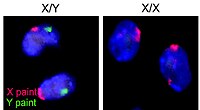
Photo from wikipedia
Rauvolfia vomitoria is widely distributed in the tropical regions of Africa and Asia, and has been used in traditional folk medicine in China. Indole alkaloids were found to be major… Click to show full abstract
Rauvolfia vomitoria is widely distributed in the tropical regions of Africa and Asia, and has been used in traditional folk medicine in China. Indole alkaloids were found to be major bioactive components, while the effects of diabetes mellitus on the pharmacokinetic parameters of the components have not been reflected in vivo. In this study, an efficient and sensitive liquid chromatography-tandem mass spectrometry method was developed and validated for the simultaneous determination of five ingredients of R. vomitoria in rats. Detection was implemented in multiple-reaction-monitoring mode with an electrospray positive-ionization source. Validation parameters were all in accordance with the current criterion. The established method was effectively employed to compare the pharmacokinetic behaviors of five alkaloids (reserpine, yohimbine, ajmaline, ajmalicine, and serpentine) between normal and type 2 diabetic rats. The single-dose pharmacokinetic parameters of the five alkaloids was determined in normal and diabetic rats after oral administration of 100 and 200 mg/kg body weight. The results indicated that diabetes mellitus significantly altered the pharmacokinetic characteristics of yohimbine, ajmaline, and ajmalicine after oral administration in rats. This is an attempt to provide some evidence for clinicians that may serve as a guide for the use of antidiabetic medicine in clinical practice. This article is protected by copyright. All rights reserved.
Journal Title: Journal of separation science
Year Published: 2021
Link to full text (if available)
Share on Social Media: Sign Up to like & get
recommendations!